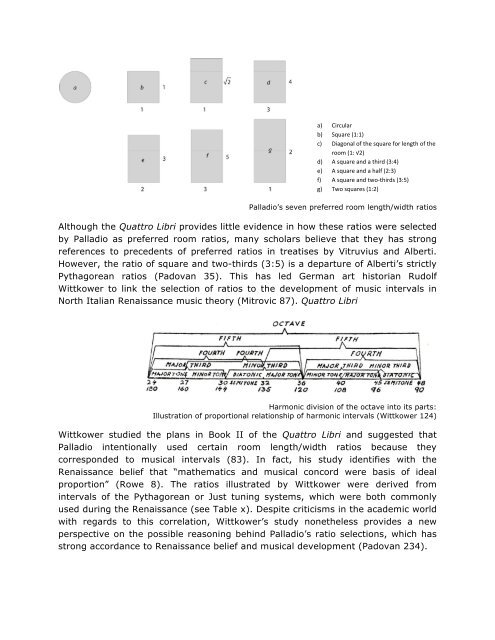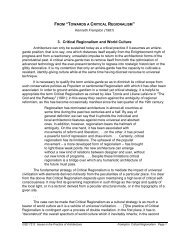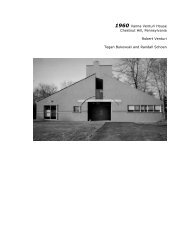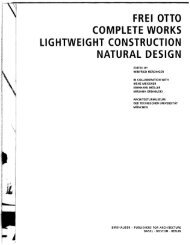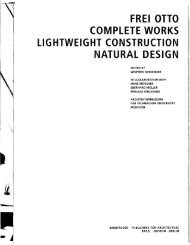Raymond Chau and Ruogu Liu
Raymond Chau and Ruogu Liu
Raymond Chau and Ruogu Liu
You also want an ePaper? Increase the reach of your titles
YUMPU automatically turns print PDFs into web optimized ePapers that Google loves.
a) Circular<br />
b) Square (1:1)<br />
c) Diagonal of the square for length of the<br />
room (1: √2)<br />
d) A square <strong>and</strong> a third (3:4)<br />
e) A square <strong>and</strong> a half (2:3)<br />
f) A square <strong>and</strong> two-‐thirds (3:5)<br />
g) Two squares (1:2)<br />
Palladio’s seven preferred room length/width ratios<br />
Although the Quattro Libri provides little evidence in how these ratios were selected<br />
by Palladio as preferred room ratios, many scholars believe that they has strong<br />
references to precedents of preferred ratios in treatises by Vitruvius <strong>and</strong> Alberti.<br />
However, the ratio of square <strong>and</strong> two-thirds (3:5) is a departure of Alberti’s strictly<br />
Pythagorean ratios (Padovan 35). This has led German art historian Rudolf<br />
Wittkower to link the selection of ratios to the development of music intervals in<br />
North Italian Renaissance music theory (Mitrovic 87). Quattro Libri<br />
Harmonic division of the octave into its parts:<br />
Illustration of proportional relationship of harmonic intervals (Wittkower 124)<br />
Wittkower studied the plans in Book II of the Quattro Libri <strong>and</strong> suggested that<br />
Palladio intentionally used certain room length/width ratios because they<br />
corresponded to musical intervals (83). In fact, his study identifies with the<br />
Renaissance belief that “mathematics <strong>and</strong> musical concord were basis of ideal<br />
proportion” (Rowe 8). The ratios illustrated by Wittkower were derived from<br />
intervals of the Pythagorean or Just tuning systems, which were both commonly<br />
used during the Renaissance (see Table x). Despite criticisms in the academic world<br />
with regards to this correlation, Wittkower’s study nonetheless provides a new<br />
perspective on the possible reasoning behind Palladio’s ratio selections, which has<br />
strong accordance to Renaissance belief <strong>and</strong> musical development (Padovan 234).


